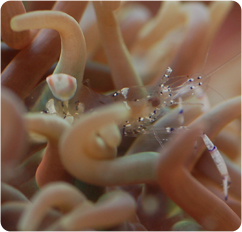|
Life of the Reef - Symbiosis
Relationships That Work on the Reef & in the Aquarium 
A tropical reef is a tapestry of interconnected life. While that may sound peacefully bucolic, the reality is far from pastoral. The tropical reef is a highly competitive environment where every organism is literally engaged in a daily battle for survival. Whether it’s competing for space, food or the opportunity to reproduce, the tropical reef is not quite the home sweet home Disney portrayed in Finding Nemo. While Disney may have been sloppy in terms of ecological accuracy and animal behavior, the movie did highlight some of the more interesting symbiotic reef relationships (e.g. Jacques or Nemo himself). These symbiotic relationships, whether mutualistic or commensal, make it possible for many reef organisms to survive, and they are the topic of this article.
Whether it’s a clownfish and an anemone; a shrimp from the genus Thor (e.g., sexy shrimp) and an Euphyllia spp. (e.g., torch coral); a shrimp from the genera Periclimenes (e.g., glass shrimp) or a crab from the genus Neopetrolisthes (e.g., porcelain crab) and an urchin, nudibranch or anemone; an alpheid shrimp (e.g. pistol shrimp) and a goby (e.g., yasha hase goby); or a cleaner shrimp from the Lysmata or Stenopus genera (e.g., cleaner shrimp) and a fish that employs their services, these symbiotic animals make for some of the most interesting displays in the home aquarium.
Symbiosis – What is It?
Symbiosis describes a relationship between two organisms, and there are a variety of different symbiotic relationships that can be observed on the reef. They are:
- Mutualistic
- Commensal
- Parasitic
Aquarists generally try to avoid the last, but encouraging mutualistic and commensal relationships in the aquarium can be a very rewarding experience. In mutualistic relationships both organisms benefit from the relationship, while in commensal relationships, only one organism benefits while the other neither benefits nor suffers.
Read More:
Symbiotic Shrimp
Symbiotic Crabs
Symbiotic Gobies
Published 8 September 2008. © Blue Zoo Aquatics
|